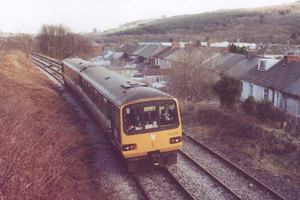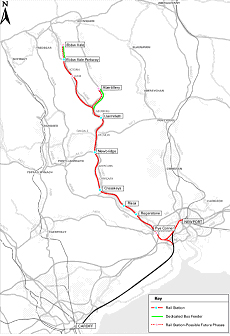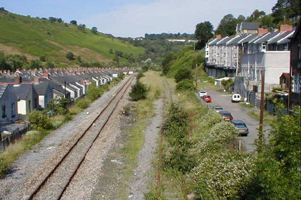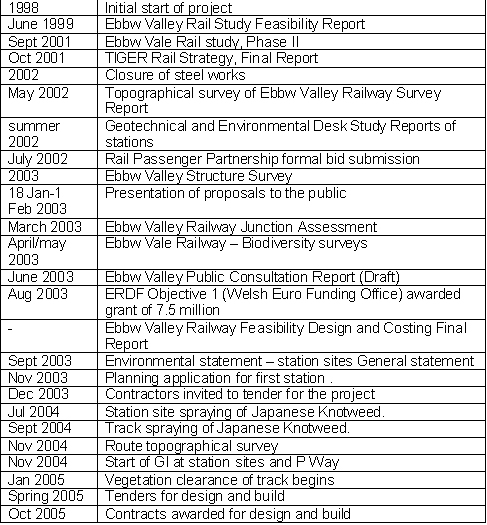 |
 |
 |
 |
 |
 |
 |
 |
 |
 |
 |
 |
Project description
Name of the case study
Ebbw Valley Railway
Description of context
• The National Assembly for Wales has a legal duty to pursue sustainable development in all it does. This is built into its constitution through section 121 of the Government of Wales Act.
• The Wales Spatial Plan: People, Places, Future (November 2004) – sets an agenda for Wales for the next twenty years, which includes improved transport links to strengthen and reintegrate the existing system of cities and towns within South East Wales, create a coherent urban network to compete internationally.
• Planning Policy Wales (March 2002) states that "Local authorities should promote public transport as a means to achieve environmental objectives, to assist in relieving congestion and to encourage social inclusion". It suggests that Local Authorities could investigate the opening or reopening of railway lines, the provision of new stations and increased passenger services on existing lines, as a way of regenerating areas and creating new development.
• Planning Policy Wales (March 2002) also identified Blaenau Gwent, one of the local authorities within the area as part of an area for economic growth and regeneration.
• Blaenau Gwent is within the West Wales and Valleys area which is eligible for funds from the European Fund Objective 1 status.
• Blaenau Gwent Unitary Development Plan (long term local development plan) includes the Ebbw Valley Railway service, and outlines land to be safeguarded for station developments.
• The Transport Framework for Wales (March 2001) specifies how the National Assembly for Wales aims to lead and support the delivery of the transport infrastructure and services that are needed in Wales internally and to connect Wales to the rest of the world.
Description of project - background
The Ebbw Valley links the town of Ebbw Vale with the coastal plain in South East Wales. Ebbw Vale was once a thriving town based around an iron and steel works. However, during the late twentieth century steel production transferred to Newport, resulting in a economic and social decline of the Ebbw Valley. The original Ebbw Valley passenger service ceased in 1962, when many branch railway lines were shut around Britain. Since then the railway was used for freight transportation until the closure of the steel works in 2002. A very limited freight traffic continued to use the line to transport the scrap material from the steel works site.
The Ebbw Valley Railway project is promoted by the councils of Blaenau Gwent, Caerphilly and Newport through which the rail line runs and is supported by the South East Wales Transport Alliance. In addition the passenger service is a key component of the Five Counties Regeneration Framework, which was developed in response to the closure of Ebbw Vale steelworks and the termination of steel production in Newport.

Passenger Railway in Ebbw Valley
The Ebbw Valley Railway will run along the former freight line between Ebbw Vale and the South Wales Main Line to provide direct passenger services to the cities of Cardiff and Newport. Six new stations, Rogerstone, Risca & Pontymister, Crosskeys, Newbridge, Llanhilleth and Ebbw Vale Parkway, will serve local communities. Housing developments are taking place in these areas as a result of rising house prices in Newport and Cardiff, and an overall increase in the demand for housing, this will result in increased transportation requirements. If a reliable service can be provided it is likely to be successful. Considerable engineering work is required to the line in order for the proposed 54 minute passenger service to run efficiently. Construction of new stations, together with road and pedestrian access, interchange facilities and parking is also required.

Locations of the new passenger stations along the Ebbw Valley
The stations have been located to provide good accessibility for communities along the valley. Considerations when deciding the station locations included:
• Engineering feasibility – Track Gradients, Track Curvature,
• General feasibility - Land availability, Sufficiency of land for parking, passenger drop-off etc.,
• Accessibility - Proximity to population centre and key demand destinations, proximity of bus services, site access arrangements,
• Operational Impact,
• Traffic Impact,
• Cost.
The stations will be unmanned halts with tickets available on the trains. Platforms will accommodate trains of up to 4 coaches. Trains are proposed to run every 30 minutes while allowing one freight train per day. Passenger facilities include platform canopies and seating. The station design has incorporated:
• passenger and railway industry standards, DDA regulations, guidance and best practice requirements,
• minimisation of impacts on the surrounding area,
• car and bicycle parking areas (multi-modal journeys),
• provision for setting down/picking up,
• interchange opportunities with local bus services.
In addition to the construction of the 6 new stations other development includes upgrading the existing freight track to passenger standards, re-instatement of double track over approximately 3 miles from the new station at Risca to Crosskeys to form a passing loop, new colour light signalling, and upgrading of existing signalling at Park Junction. A second phase will extend the second track from Crosskeys to the former Aberbeeg junction.
It is believed that railway users will comprise 1/3 ex-bus passengers, 1/3 ex-car users and 1/3 new travellers. Careful consideration has been made for passenger safety and personal security by avoiding hidden spaces and promoting natural surveillance and the inclusion of high quality lighting, closed circuit television and two way help points.
Later development stages propose additional intermediate stations, and extended lines to Ebbw Vale Town Centre and Abertillery, replacing the feeder bus service.

Ebbw Valley Railway line – single track area
Description of project - objectives/aims
• provide access to work, education, training, health and leisure activities within the valley and in the coastal plain of Newport and Cardiff, for residents of Blaenau Gwent County Borough Council, Caerphilly County Borough Council and Newport City Council. These are areas with particularly high levels of unemployment and economic inactivity associated with the decline of the coal, steel and related industries over the past three decades;
• provide a catalyst to stimulate economic regeneration within Blaenau Gwent and Caerphilly County Boroughs;
• contribute to the wider aims of the national government, the Welsh Assembly Government and the local authorities in the SEWTA consortium in providing sustainable alternatives to the car, particularly for travel to the M4 corridor and the south Wales coastal plain.
Description of project - time interval and stages
Time interval and stages of project realisation are illustrated in the table below.

Description of project - financing
The capital cost of the project was estimated at £27.2 million in 2002. The Welsh Assembly Government awarded £7 million from the Corus Re-development fund in 2002. Funding totalling £7.5 million was awarded by ERDF Objective 1 (Welsh European Funding Office) in August 2003. The balance of the funding is being sought from the Transport Grant. The service is being underwritten for the first three years by the Welsh Assembly Government, together with £4 million of capital funding obtained from Rail Passenger Partnership Fund of the Strategic Rail Authority.
Description of project - other sectors involved
-
What tools were used to assess sustainability?
Demand forecasts
Environmental Impact Assessment and Environmental Impact Assessment
Public consultation exercise
Road side questionnaires
More information